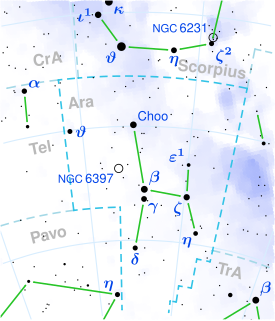Related Research Articles
Gamma Sextantis, Latinized as γ Sextantis, is a binary star system in the equatorial constellation of Sextans. The combined apparent visual magnitude of the system is 5.05, which means it is faintly visible to the naked eye. The annual parallax shift is 11.75 mas, indicating a distance of around 280 light years.

Pi Capricorni, Latinized from π Capricorni, is a triple star system in the southern constellation of Capricornus. It has the traditional star name Okul or Oculus. This system appears blue-white in hue and is visible to the naked eye as a 5th magnitude star. It is located approximately 660 light years distant from the Sun based on parallax, but is drifting closer with a radial velocity of −13 km/s.
HD 188385 is an A-type star in the equatorial constellation of Aquila.
HD 191984 is a double star in the equatorial constellation of Aquila. As of 2011, the components have an angular separation of 2.52″ along a position angle of 205.7°.
HD 187734 is double star in the equatorial constellation of Aquila. The primary is a magnitude 6.6 giant star, while the companion is a magnitude 9.4 A-type main sequence star. As of 2014, the pair had an angular separation of 5″ along a position angle of 99°.
HD 157753 is giant star in the southern constellation of Ara. It may be an astrometric binary, and it has a faint, magnitude 13 companion at an angular separation of 31.5″ along a position angle of 356°.
HD 156091 is a double star in the southern constellation of Ara. The primary is a sixth magnitude giant star with stronger than normal lines of carbon, nitrogen, and barium in its spectrum. The companion is a 13th magnitude star at an angular separation of 27.4″ along a position angle of 275°, as of 2000.
HD 150576 is a double star in the southern constellation of Ara. It has a twelfth magnitude companion at an angular separation of 28.3″ along a position angle of 39°.

HD 158220 is a giant Be star in the southern constellation of Ara. This is a pulsating variable star that changes brightness by an amplitude of 0.030 magnitude over a period of 1.15 days.

HD 158476 is a supergiant star in the southern constellation of Ara. There is a faint magnitude 10.5 companion at an angular separation of 20.0″ along a position angle of 209°.
HD 153791 is a double star in the southern constellation of Ara. The primary is a sixth magnitude A-type main sequence star. It has a magnitude 12.3 companion at an angular separation of 6.0″ along a position angle of 249°, as of 1999.
HD 156331 is double star in the southern constellation of Ara. As of 2014, the pair have an angular separation of less than an arc second along a position angle of 49°.
HD 151566 is double star in the southern constellation of Ara. As of 1991, the pair had an angular separation of 3.10″ along a position angle of 42°.
HD 34790 is a double-lined spectroscopic binary star system in the northern constellation of Auriga. It has a combined apparent magnitude of 5.66, which means it is faintly visible to the naked eye. Based upon observations by the Hipparcos satellite, it is located around 289 light years away. It has a combined stellar classification of A1Vs, matching that of an A-type main sequence star, and shines with 35 times the luminosity of the Sun.
HD 135438 is a K-type giant star in the northern constellation of Boötes. It has a magnitude 9.36 companion at an angular separation of 118.2″ along a position angle of 158°.
HD 127304 is a double star in the northern constellation of Boötes. The brighter component is a sixth magnitude A-type main sequence star with a stellar classification of A0Vs It has a faint magnitude 10.62 companion at an angular separation of 25.6″ along a position angle of 256°.
HD 132029 is a star in the northern constellation of Boötes. It forms a double star with a magnitude 10.2 companion at an angular separation of 4.6″ along a position angle of 110°.
HD 130603 is a double star in the northern constellation of Boötes. As of 2010.476, the components have an angular separation of 2.06″ along a position angle of 54.7°.
HD 128093 is a double star in the constellation Boötes. The brighter component is an F-type main-sequence star with a stellar classification of F5V and an apparent magnitude of 6.33. It has a magnitude 11.33 companion at an angular separation of 28.1 along a position angle of 318°.
HD 131473 is a binary star system in the northern constellation of Boötes. The primary is an F-type subgiant with a stellar classification of F4IV, while its companion is a G-type subgiant with a stellar classification of G1IV.
References
- 1 2 3 4 5 van Leeuwen, F. (2007), "Validation of the new Hipparcos reduction", Astronomy and Astrophysics, 474 (2): 653–664, arXiv: 0708.1752 , Bibcode:2007A&A...474..653V, doi:10.1051/0004-6361:20078357, S2CID 18759600
- 1 2 3 4 Lutz, T. E.; Lutz, J. H. (June 1977), "Spectral classification and UBV photometry of bright visual double stars", Astronomical Journal, 82: 431–434, Bibcode:1977AJ.....82..431L, doi:10.1086/112066
- ↑ Halliday, Ian (September 1955), "Luminosity Function and Space Motions of G8-K1 Stars Derived from Spectroscopic Parallaxes", Astrophysical Journal, 122: 222, Bibcode:1955ApJ...122..222H, doi:10.1086/146080
- ↑ Wilson, R. E. (1953), "General Catalogue of Stellar Radial Velocities", Carnegie Institute Washington D.C. Publication, Carnegie Institute of Washington, D.C., Bibcode:1953GCRV..C......0W
- 1 2 McDonald, I.; Zijlstra, A. A; Boyer, M. L. (2012). "Fundamental Parameters and Infrared Excesses of Hipparcos Stars". Monthly Notices of the Royal Astronomical Society. 427 (1): 343–57. arXiv: 1208.2037 . Bibcode:2012MNRAS.427..343M. doi:10.1111/j.1365-2966.2012.21873.x. S2CID 118665352.